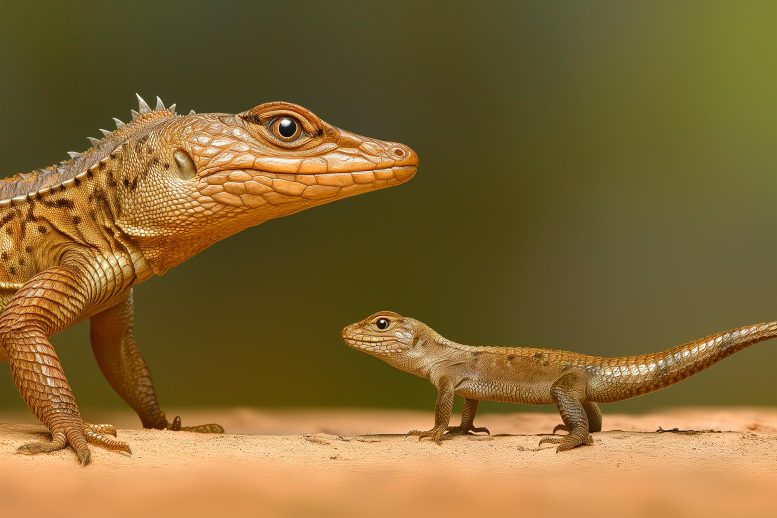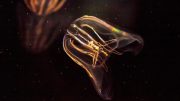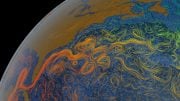
A recent study uncovers the factors influencing animal size changes over time, identifying three evolutionary patterns based on competition and environmental pressures, providing clarity on the inconsistencies in fossil records. Credit: SciTechDaily.com
New research reveals key factors behind the changing sizes of certain animals over time, challenging traditional evolutionary theories with its findings on species’ size variations.
The mystery behind why Alaskan horses, cryptodiran turtles, and island lizards shrunk over time may have been solved in a new study.
The new theoretical research proposes that animal size over time depends on two key ecological factors: the intensity of direct competition for resources between species, and the risk of extinction from the environment.
Study Findings and Ecological Factors
Using computer models simulating evolution, the study, published today (Thursday, January 18) in the journal Communications Biology, identifies why some species gradually get smaller, as indicated by fossil records.
Dr. Shovonlal Roy, an ecosystem modeler from the University of Reading who led the research, said: “Just like how we try to adapt to hot or cold weather depending on where we live, our research shows animal size can get bigger or smaller over long periods depending on the habitat or environment.
“In places and times where there’s lots of competition between different species for food and shelter, animal sizes often get smaller as the species spread out and adapt to the distribution of resources and competitors. For example, small horses that lived in Alaska during the Ice Age rapidly shrank due to changes in the climate and vegetation.
“Where direct competition is less, sizes tend to get bigger, even though being really big and few in number can make animals more vulnerable to dying out – such as what happened with the dinosaurs.
“Changes in ecological factors help explain why fossil records shows such confusing mixes of size evolution patterns, with some lineages shrinking over time and others growing.”
Cope’s Rule
The research team carried out their study by challenging the contradictions fossil evidence posed to “Cope’s rule.” Cope’s rule refers to the tendency for certain animal groups to evolve larger body sizes over thousands and millions of years. The rule is named after Edward Cope, a 19th-century paleontologist who was credited to have first noticed this pattern in the fossil record. For example, early horse ancestors were small dog-sized animals that increased in size over evolutionary time, ultimately producing the modern horse.
However, fossil evidence shows remarkably conflicting trends, with increased size in some groups but decreased size in others.
Evolutionary Pressure
Using computer models simulating evolution, the study identified three distinct patterns of body-size change emerging under different conditions:
- Gradual size increase over time: This happens when competition between species is determined mostly by their relative body sizes rather than niche differences. For example, several genera of marine animal species (e.g. invertebrates) gradually increased in size over millions of years.
- Size increase followed by extinctions: Here the largest animals recurrently go extinct, opening opportunities for other species to take their place and evolve even bigger bodies, continuing the cycle. Mass extinctions hit large-bodied apex predators hardest. Very large mammals and birds are particularly vulnerable to extinction – for example, dinosaurs and giant flying reptiles.
- Gradual size decrease over time: The simulations also predicted the opposite of Cope’s rule: species shrinking over time. This happens when competition is high and there is a degree of overlap in habitat and resource use. As species evolve apart into distinct niches, they face evolutionary pressure to reduce in size. Decline in size was previously reported for vertebrates, bony fish, cryptodiran turtles, Alaskan Pleistocene horses, and island lizards.
Reference: “Ecological determinants of Cope’s rule and its inverse” by Shovonlal Roy, Åke Brännström and Ulf Dieckmann, 18 January 2024, Communications Biology.
DOI: 10.1038/s42003-023-05375-z









I guess it’d be more like this; At first they establish themselves my dominating themselves and their environment but once they’ve succeeded, they only have to worry about each other.
I thought this was kind of obvious? When reproductive success depends on smaller size, that’s what you get and vice versa.
Decline in size is also evident in Dinosaurs and Mammals. At first they gradually get really big, and then over protracted time periods they gradually get smaller. They not only respond to the environment, they also respond to the very gradual increase in Earth’s mass and surface gravity. For Example, at a maximum, Sauropods reached a maximum of 17 times the Volume of Male African Elephants. They were constructed of the same materials as Elephants, but lived in a lower surface gravity. To estimate take 17^(2/3) and divide it by 17 to get around 38.9 % of the current surface gravity. When you raise Volume to the (2/3) power, you get Areas. The important areas are the cross-sectional areas of legs, necks, and tails which do the structural supporting of the animal. Sauropods got Really Big, then gradually they got more massive, then they had to get smaller, and eventually by 70 Ma, went extinct. Mammals did the same thing, and they are doing the same thing. They are getting smaller as the surface gravity gradually gets larger. In the last 13,000 years it was mammoths, and mastodons. In the next few hundred years it will be African Elephants, and later on it will be Asian elephants that go extinct.
What nonsense! Earth’s mass or gravity has not changed in any significant way for billions of years.